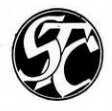

SE-015
Standard Radio STR. 9-X
Standard Telephones and Cables Ltd., London



|
SE-015
|

|
|
überarbeitet am 1.1.2013 |
As a replacement of the C-3606, the Morane D-3800 (72 pcs.) and D-3801 (289 pcs.)
aircraft, several jet fighter aircrafts have been evaluated after the end of World War II.
The hollow state VHF aircraft radio SE-015 / STR.9-X, used in the fighter aircraft de Havilland "Vampire" und "Venom", is completely crystal controlled. A simple Control Unit is used to select one of ten pre-tuned operation frequency channels, the "Push-to-Talk" switch is also located at the control unit. The aircraft radio has the characteristic modular construction: there is only space for a small control box in the cockpit of most fighter airplanes, the transceiver itself is located in an equipment bay usually located at the back of the aircraft. Several cables with multi-pole connectors (which are typically unavailable when searched for years later) connect the radio equipment with the on-board instalations of the plane. After taking away the front cover, the crystal sockets can be accessed, they
are suited to fit frequency crystals of the STC types 4004, 4044 and 4046
or the american equivalent HC/6U, the correct crystal frequency is (operation
frequency divided by 18 - 0,54 MHz). The transceiver is powered from the 26 V on-board power system of the aircraft, the heaters are powered directly, a rotary transformer is used to generate the plate voltage of 250 V and the grid voltage of 50 Volts. A crystal controlled oscillator gives a signal between 5'848 - 7'515 kHz
depending on the crystal in use, the operation frequency is generated by means
of a frequency multiplier (two frequency tripler stages 3V1 and 3V2 and a
frequency doubler stage 3V3). The operation frequency is the 18-fold of the
crytsal frequency plus 9,72 MHz of the intermediate frequency. The first four aircraft of the early DH-100 Mk 1 had the four channel STR 9 / SE-012 installed, the later DH-100 Mk 6 "Vampire" and DH-112 "Venom" came with the ten channel version STR.9X / SE-015. Later, the major part of the Swiss Air Force fleet has been equipped with this equipment, e.g. the C-3605, Pilatus P2, P3, PC-6, Do-27, Ju-52, Fieseler Storch and even the Hawker "Hunter". There also exists a 44 channel variant, the SE-015/1. I would be very thankful for further information and images. further information: © 1.1.2013 Martin Bösch |
||||